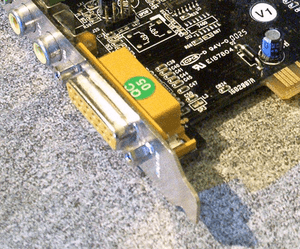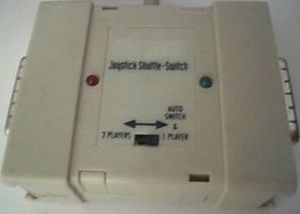Game port facts for kids
Quick facts for kids Game port |
||
|---|---|---|
 |
||
| A DA-15 connector on a Soundcard | ||
| Type | Joystick input port | |
| Production history | ||
| Designer | IBM | |
| Superseded by | USB | |
| Specifications | ||
| Hot pluggable | yes | |
| External | yes | |
| Pins | 15 | |
| Connector | DA-15 | |
| Pin out | ||
 |
||
| Pin 1 | +5V | +5V DC |
| Pin 2 | B1 | Button 1 |
| Pin 3 | X1 | X axis for joystick 1 (0–100 kΩ) |
| Pin 4 | GND | Ground for B1 |
| Pin 5 | GND | Ground for B2 |
| Pin 6 | Y1 | Y axis for joystick 1 (0–100 kΩ) |
| Pin 7 | B2 | Button 2 |
| Pin 8 | +5V | +5V DC |
| Pin 9 | +5V | +5V DC |
| Pin 10 | B4 | Button 4 |
| Pin 11 | X axis for joystick 2 (0–100 kΩ) | |
| Pin 12 | GND | Ground for buttons 3 and 4 (or MIDI out) |
| Pin 13 | Y2 | Y axis for joystick 2 (0–100 kΩ) |
| Pin 14 | B3 | Button 3 |
| Pin 15 | +5 V | +5 V DC (or MIDI in, sometimes unconnected) |
The Game port is a special connection found on some computers. It was used to plug in devices like joysticks to play computer games. Often, you'd find the game port built into a computer's sound card or directly on the motherboard.
Over time, newer connections like USB became more popular. Because of this, Microsoft stopped supporting the game port with its operating system drivers starting with Windows Vista. However, some special drivers made by other companies can still be used. There are also ways to make game port devices work with USB.
Contents
How Game Ports Work
Unlike many other computer connections, the game port uses analog signals. This means the information from the joystick is like a smooth wave, not a simple on/off signal. To be used by the computer, these analog signals need to be changed into digital signals. This job is usually done by a special part called an analog-to-digital converter.
Early joysticks were often digital, which made them simpler and cheaper to build. However, the game port used a 15-pin connector, while many older digital joysticks used a 9-pin one. This meant that older joysticks usually didn't work with the new game port without an adapter.
Digital signals are easier for computer programs to use because they are already in a format the computer understands. Analog signals are more complex. They need careful programming to read correctly and can use up more of the computer's main brain, the CPU.
Why Calibration Was Needed
Because game ports used analog signals, joysticks connected to them often needed "calibration". This was true even for joysticks like those used in arcades. Calibration was important because no two joysticks or game ports gave exactly the same measurements every time. The readings could even change based on how fast the computer's CPU was. Also, game ports could pick up electrical noise, which made readings less accurate.
Calibration helps the computer understand the full range of movement for a joystick. It involves moving the joystick to its furthest points in all directions. This helps the computer know what the "maximum" and "minimum" positions are. Modern USB joysticks do not need calibration because they send digital signals, which are much more precise.
In the past, with older operating systems like DOS, every game that used the game port had to do its own calibration. Sometimes, this happened every time you started a game! If the calibration didn't work well, the joystick might not work correctly with that game. With newer operating systems like Windows XP, you only needed to calibrate a joystick once. It would stay calibrated until you unplugged it.
Microsoft decided to stop including built-in support for game ports in its operating systems, starting with Windows XP Professional x64 Edition. They did this because USB gaming devices had become much more common. Now, if you want to use a game port, the support usually comes from the company that made your Sound card or a special USB adapter.
Expanding Game Port Abilities
Some advanced joysticks that used the game port could have more than four buttons, like six or eight. However, the game port itself only had hardware support for four buttons. To make the extra buttons work, these joysticks needed special software called a device driver.
Manufacturers found clever ways to get around this limit. They might use pins meant for a second joystick or other unused pins. Some joysticks even sent special codes using the four button inputs to allow for more combinations, though this had some limits.
High-end game port joysticks, like the Microsoft SideWinder, used a technique called multiplexing. This allowed them to send a lot of data through the standard button inputs, supporting many buttons (like 16 or 20). This also made special features possible, such as connecting multiple joysticks together (daisy-chaining), force feedback (where the joystick vibrates or pushes back), or even custom joystick programming.
The main downside was that these advanced joysticks always needed a special driver to work. Without it, they usually wouldn't function, and setting them up could take time. Despite this, some people who like to build their own computer parts or DIY projects found ways to connect many different devices to the game port. They even used it for things like measuring voltage or collecting simple data.
History of the Game Port
The game port was first designed by IBM in 1981. It was originally a separate card you could add to your computer. This early design allowed for four analog controls and four buttons on one port. This meant you could connect two joysticks or four "paddles" (simple controllers). To do this, you needed a special "Y-splitter" cable. However, some game ports, especially those combined with MIDI on sound cards, didn't fully support all four controls or buttons.
Today, new computers usually do not have a 15-pin game port. You can find adapters that let you connect older joysticks to modern computers using USB. But, as mentioned, Windows Vista and newer operating systems from Microsoft don't have built-in support for game ports, even with USB adapters.
MIDI Connections
Game ports use a type of connector called DA-15. Around 1990, the game port started to be included on sound cards instead of separate expansion cards. To make the most of this, two of the pins that were originally for power were changed to be used for MIDI (Musical Instrument Digital Interface) input and output. MIDI is a way for electronic musical instruments to communicate with computers.
To connect MIDI instruments to a game port, you need a special cable. This cable has a DA-15 connector for the computer and two 5-pin DIN connectors for the MIDI instruments. The game port's MIDI features are based on a standard called Roland MPU-401, which means they work with most MIDI applications for Windows and DOS.
Images for kids
See also
 In Spanish: Puerto de juegos para niños
In Spanish: Puerto de juegos para niños



